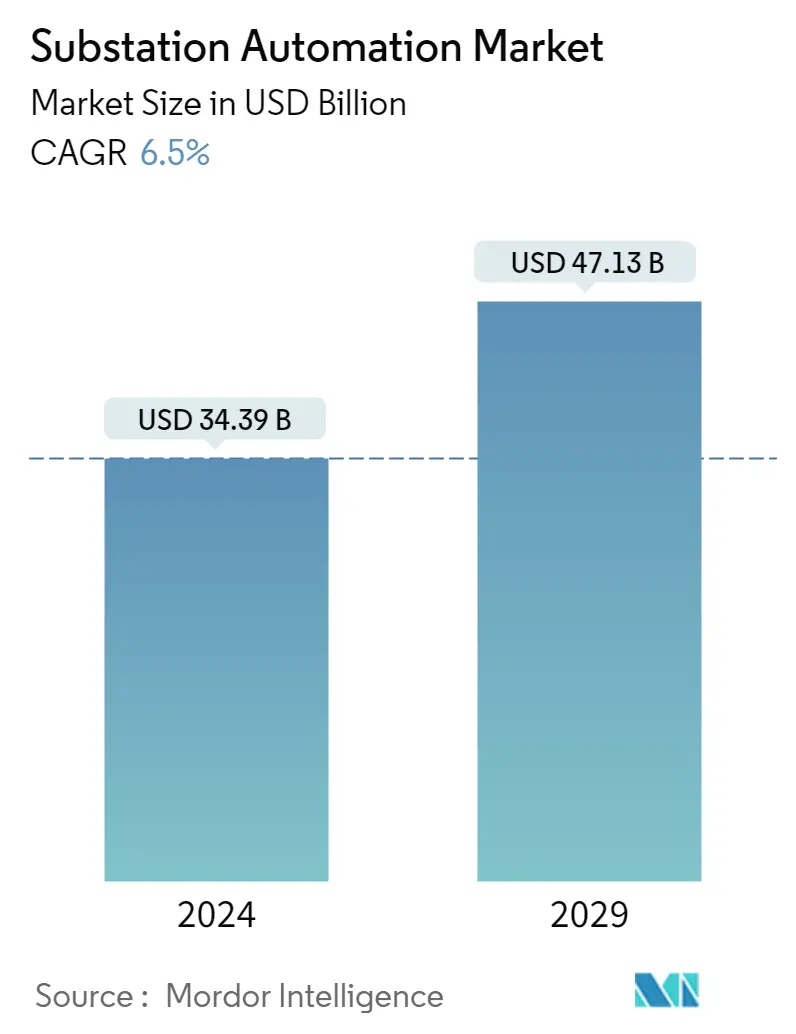Market Size of Substation Automation Industry

| Study Period | 2019 - 2029 |
| Market Size (2024) | USD 34.39 Billion |
| Market Size (2029) | USD 47.13 Billion |
| CAGR (2024 - 2029) | 6.50 % |
| Fastest Growing Market | Asia Pacific |
| Largest Market | North America |
Major Players
*Disclaimer: Major Players sorted in no particular order |
Substation Automation Market Analysis
The Substation Automation Market size is estimated at USD 34.39 billion in 2024, and is expected to reach USD 47.13 billion by 2029, growing at a CAGR of 6.5% during the forecast period (2024-2029).
With the widening supply and demand gap, the power management has become one of the most critical worldwide concern areas. Energy consumption is increasing at one of the fastest rates globally; hence, the requirement of substation automation systems in the present-day substations to efficiently control and deliver power is highly sought.
- Substation automation provides protection, control, automation, monitoring, and communication capabilities as a part of comprehensive substation control and monitoring solution. Today, the substation layout is much cleaner. One can probably eliminate entire writing racks and cabinets or make them much smaller depending on how users handle their I/Os to the IEDs (intelligent electronic devices). High-speed microprocessor-based remote terminal units or smart electronic devices are used for substation automation and protection.
- The migration toward the future transmission and distribution substation is taking place because of the desire to bring more automation and intelligence to the power grid network to address a myriad of utility concerns, such as how to reduce operational expenses to ways to meet new regulatory requirements, such as NERC-CIP (North American Electric Reliability Corporation - Critical Infrastructure Protection).
- According to Smart Energy International, it is estimated that Europe will spend USD 23.9 billion to automate or monitor secondary substations over the next decade. Utilities in countries including France, Italy, and Spain are expected to be the highest investors in equipment and services, enabling the automation of substations.
- The smart electric substation's role in smart cities has become more critical than the traditional one. The key benefits derived from substation automation are increased reliability, early detection of faults and quick diagnosis, improved worker safety, and enhanced utilization of the smart city infrastructure.
- Further, the companies are allying to help digitize the grid and make it data-driven to meet carbon neutrality. For instance, recently, Enedis, Capgemini, and Minsait have joined the edge for smart secondary substations alliance, formed to develop a standard, flexible, manageable, and interoperable platform for next-generation smart grids.
- Additionally, the Indian government allocated INR 6,450 crore (~USD 868 million) for the smart cities mission under Union Budget 2021-2022, compared to INR 3,400 crore (~USD 457 million) in FY2021.
- Furthermore, COVID-19 impacted the electric grid usage patterns in the initial stage. But as things started to get regular and the market gained traction, the demand for electricity increased, thereby increasing the need for the market studied. As per IEA, electricity consumption globally was 25,300 terawatt-hours in 2021 and 23,966 terawatt-hours in 2020.
Substation Automation Industry Segmentation
Substation automation includes using data from intelligent electronic devices (IEDs) to control & automation capabilities within the substation and control commands from remote users to control power system devices. The features of substation automation are monitoring and controlling of substation devices using modules such as intelligent electronic devices) (IEDs) and two-way communications through remote access. The aim is to monitor and control the substation instruments to reduce the incidence and duration of power outages.
The scope of the study covers different types of substations and their uses in various end-user industries. The report further covers the major vendors operating in the market and their strategies to expand their market presence. The study further analyzes the overall impact of COVID-19 on the ecosystem and encompasses market sizing and forecast for segmentation by type, module, communication, stage, end-user industry, and geography. The market sizes and forecasts are provided in terms of value (USD million) for all the above segments.
| By Type | |
| Transmission | |
| Distribution |
| By Module | |
| IED | |
| RTU | |
| BCU | |
| SCADA |
| By Communication | |
| Wired | |
| Wireless |
| By Stage | |
| Retrofit | |
| New |
| End user | |
| Utility | |
| Industry |
| Geography | |
| North America | |
| Europe | |
| Asia Pacific | |
| Rest of the World |
Substation Automation Market Size Summary
The substation automation market is poised for significant growth, driven by the increasing demand for efficient power management solutions globally. As energy consumption surges, the need for advanced substation automation systems becomes critical to manage and deliver power effectively. These systems offer comprehensive control, monitoring, and communication capabilities, enhancing the reliability and safety of power distribution. The transition towards smarter grids is fueled by the desire to reduce operational costs and meet regulatory requirements, such as those set by the North American Electric Reliability Corporation. The integration of renewable energy sources and the deployment of innovative grid communication technologies further propel the market, as they enable predictive data management and improved security.
The market landscape is highly competitive, with key players investing in research and development to innovate and expand their product offerings. Strategic partnerships and collaborations are common, as companies aim to advance low-carbon and efficient energy solutions. Notable developments include the expansion of digital substation facilities and the deployment of digital substations to enhance grid reliability. The market's growth is also supported by government initiatives and investments in smart city projects, which emphasize the importance of substation automation in modernizing energy infrastructure. As the demand for reliable and efficient power systems continues to rise, the substation automation market is expected to experience robust expansion in the coming years.
Substation Automation Market Size - Table of Contents
-
1. MARKET DYNAMICS
-
1.1 Market Drivers
-
1.1.1 Need to Upgrade the Existing Networks
-
-
1.2 Market Restraints
-
1.2.1 High cost of installation
-
-
-
2. MARKET SEGMENTATION
-
2.1 By Type
-
2.1.1 Transmission
-
2.1.2 Distribution
-
-
2.2 By Module
-
2.2.1 IED
-
2.2.2 RTU
-
2.2.3 BCU
-
2.2.4 SCADA
-
-
2.3 By Communication
-
2.3.1 Wired
-
2.3.2 Wireless
-
-
2.4 By Stage
-
2.4.1 Retrofit
-
2.4.2 New
-
-
2.5 End user
-
2.5.1 Utility
-
2.5.2 Industry
-
-
2.6 Geography
-
2.6.1 North America
-
2.6.2 Europe
-
2.6.3 Asia Pacific
-
2.6.4 Rest of the World
-
-
Substation Automation Market Size FAQs
How big is the Substation Automation Market?
The Substation Automation Market size is expected to reach USD 34.39 billion in 2024 and grow at a CAGR of 6.5% to reach USD 47.13 billion by 2029.
What is the current Substation Automation Market size?
In 2024, the Substation Automation Market size is expected to reach USD 34.39 billion.

